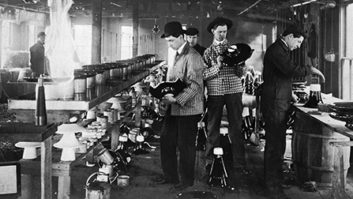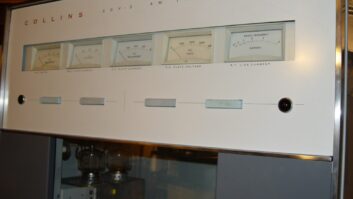Yep, you caught us. The following article from Radio World was an April Fool���s. Among the clues: Spell the authors’ names backwards; and note the first letters of the secondary headline spell out a message.
For the past year, engineers at AM Virtual Antenna (AM-VA) have been developing a radical new antenna concept for use in commercial AM broadcasting.
AM-VA began working toward the ultimate AM antenna solution when a commercial broadcaster retained AM-VA to find a solution to an AM antenna problem. Specifically, their AM towers were condemned by their city of license, and they didn’t want to abandon their antenna site.
The problem was simple. How could they continue to broadcast without their towers?
We knew that the electric field (E) that would be produced from a current flowing in a vertical antenna element is
E = 59.96 I (1 – cos(G)) mV/m
Where G is the electrical height of the element in electrical degrees and I is the current at the current loop in amperes.
So, our objective was to come up with a new design that would produce an equivalent electric field intensity at one kilometer without the use of a tower as the antenna.
New antenna installed below ground
The solution we chose was based on the use of a virtual antenna.
We knew that an antenna above a ground plane could be modeled by creating a virtual tower underneath the ground plane. Using this theory, we built a test facility where we could put the virtual portion of the antenna above the ground plane and put the metallic portion of the antenna below the ground plane.
(click thumbnail)Illustration of AM-Virtual Antenna (AM-VA) ConceptAs shown to the left in Fig. 1, the usual mode of operation for a monopole above ground results in a virtual antenna below the ground plane.
By exchanging the positions of the real antenna structure and the virtual antenna structure, we are able to accomplish the configuration as shown to the right in the figure.
Notice also that the actual length of the buried monopole is reduced as a result of the increased permittivity of the ground, which serves to increase the electrical length of the antenna.
In the test phase, we initially decided to use a pile driver to drive a metallic pile into the ground below a ground plane as the test antenna.
This proved impossible due to the layers of rock below the ground. Each test pile would stop at the rock layer. The breakthrough came when we went to an oil drilling rig which could drill through the rock.
This also allowed us to drill multiple holes in a triangular pattern creating an underground virtual tower. The large face size of this tower gave us an opportunity to improve the base impedance bandwidth of our virtual tower model for use with AM digital IBOC tests.
In order to feed the test model of our AM-Virtual Antenna we installed an insulator on top of the virtual antenna by attaching a top plate to the top of the three oil well pipes that were installed one quarter-wave into the ground. On top of this plate, we installed a three-foot-tall glass insulator.
Finally, we installed a one-quarter-wave radius circular ground plane above the ground and attached it to the top of the insulator. We fed the AM-VA at the junction of this ground plane and the top plate of the oil well pipes.
In order to monitor the performance of the AM-VA, we installed two sampling loops underneath the ground plane to sample the induced current in the ground system. In this way, we could look at the base impedance of the AM-VA and the effective current in the virtual monopole above the ground.
Prior to installing the AM-VA, we installed a temporary antenna above the ground plane in order to make measurements of the ground conductivity along eight radials. This allowed us to make predictions of the field values that we hoped to measure once the AM-VA was tested.
We knew that the field at one mile for our AM-VA above a perfectly conducting earth would by 194.9 MV/M if we fed one kilowatt into the antenna. With known conductivity, we were ready to make field trials.
Using seven-and-one-half-minute USGS Topographical Maps, we established a set of measurement points for our initial field trial. We were fortunate to find a used AM Field Intensity Meter (FIM-41, serial number 105) and an impedance R – F bridge (General Radio type 1606-A, serial number 1115) which had been previously owned by a broadcast consulting firm.
Initial results were not as good as were expected. Upon further investigation, we realized that by utilizing the virtual portion of the antenna, we had to modify the architecture to make use of perfect magnetic conductors (PMCs) rather than the perfect electrical conductors (PECs) as are used for the standard antenna radiators.
PMCs, which reflect the magnetic component of the electromagnetic (EM) wave with a phase reversal while not modifying the phase of the E-field, were first conceptualized for theoretical analyses, but physical realizations approximating PMCs have recently been synthesized using metamaterial approaches. We have applied these concepts in a novel treatment of the ground surface where ground radials would normally be installed.
The results with the PMC modifications in place have so far been above our expectations.
For example, we found that our AM-VA produced excellent coverage in underground environments (e.g. urban underground facilities, tunnels, subways, mines, shelters). This unexpected advantage of the AM-VA is being studied now by the United States government as a way to better communicate with miners in times of emergency. A DoD initiative relating to use of the AM-VA for submarine communications is also pending.
We will be submitting a paper for presentation at the IEEE 2nd International Conference on Wireless Communication in Underground and Confined Areas in Quebec, Canada.
One interesting and unexpected result of our AM-VA field test involved the cattle that were grazing on the pasture where our field tests were performed.
The owner of the cattle herd indicated that his animals grazing on top of our AM-VA installation increased in body weight and weekly body weight gain when compared to similar animals in different locations on his ranch.
We were surprised by this unexpected positive result, but then found an article in the IEEE Antennas & Propagation magazine (Volume 49, No. 4, August 2007) written by James C. Lin wherein Mr. Lin found this same result from the magnetic fields near 735 KV AC high-tension power-transmission-line exposure.
One wonders if the use of the AM-VA in heavily populated communities will have a similar health benefit to the local community living near the antenna.
With our initial tests results in, our next step will be to formally file the test results with the FCC and to ask for approval of this new technology. We hope to have this accomplished by the end of the year and will post updates as they are available at www.am-va.com.
Comment on this or any article. Write to [email protected].










